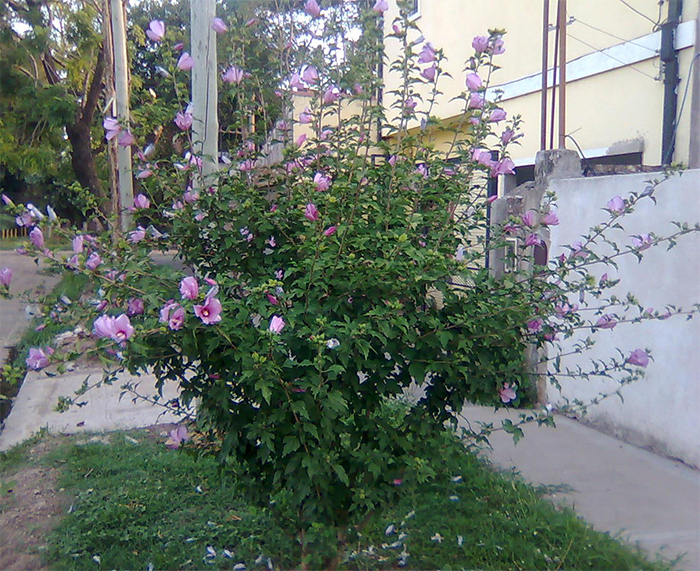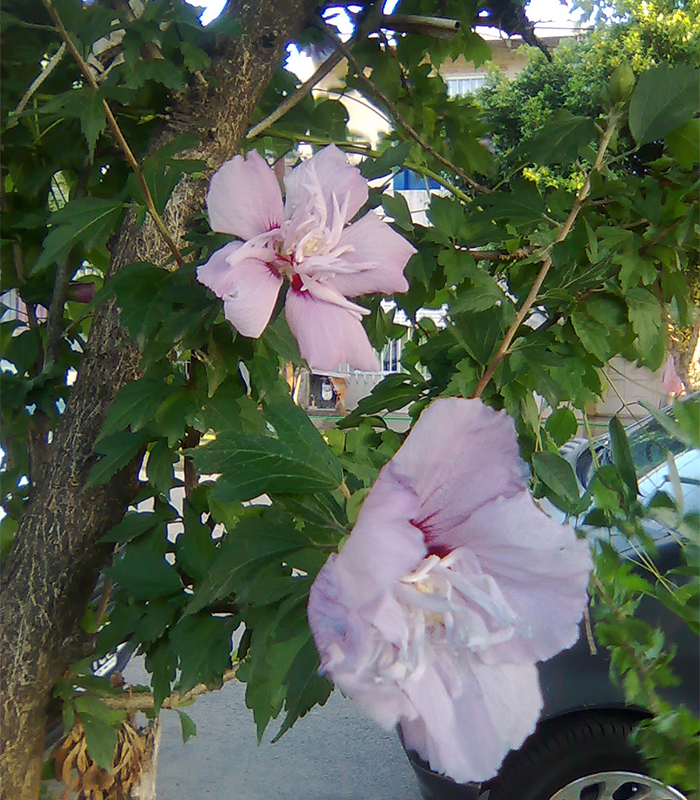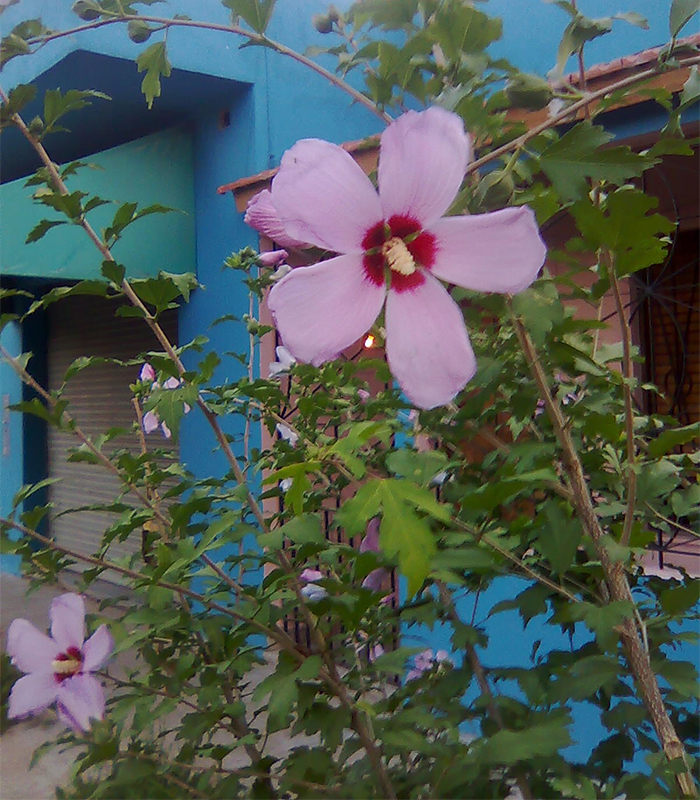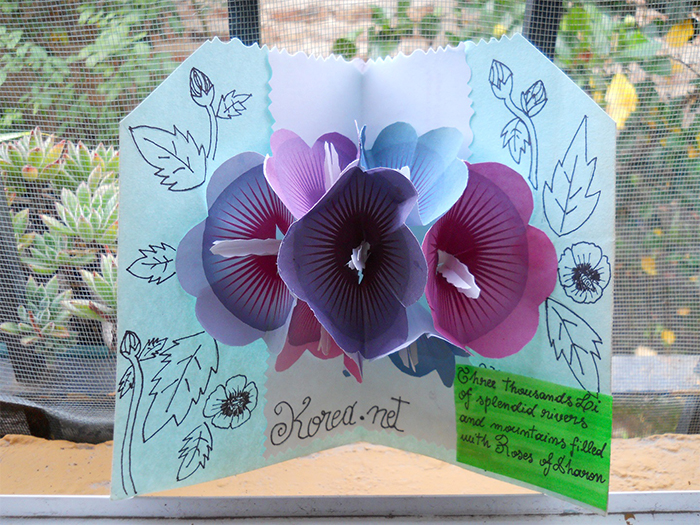View this article in another language
- 한국어
- English
- 日本語
- 中文
- العربية
- Español
- Français
- Deutsch
- Pусский
- Tiếng Việt
- Indonesian
When I was a little girl, we had in our garden a beautiful tall plant all covered in purple and blue flowers. It was a charming sight, but unfortunately my mom had to remove it in order to build a wall. That was sad, but I keep good memories of it. Today, I know this is Korea’s national flower and it has strong symbolism, just as strong as the plant itself.

It's binomial nomenclature is Hibiscus syriacus and in Korean it's known as the mugunghwa hibiscus (무궁화). In English it's sometimes called the Rose of Sharon and in Spanish it's the Rosa de Siria.
The Rose of Sharon is currently in bloom and colors our gardens and sidewalks in Buenos Aires and all over Argentina, since we just entered summer. We can enjoy the flowers from early December until late April. The main characteristic is the endurance of the plant. That’s why it's very common to see them on alongside sidewalks and in parks. They require minimum maintenance, grow fast and can survive even when damaged. This is a good explanation as to why the modern state of South Korea adopted this flower as an emblem, as the flower represents the people's longing for a lasting system of national development and prosperity, and because it symbolizes the victories and struggles that the Korean people have suffered throughout time immemorial.

If you want to cultivate a Rose of Sharon, just as I want to do, the easiest way is to buy one from a local garden center, or ask someone who owns one for a few cuttings from the plant.
The summer is the best season for this method. I recommend putting the cuttings into a pot with fertilized soil. When you notice the plant growing, you can decide whether to leave it there or to put it in the ground.
I decided to go for a walk the other afternoon to take some pictures of these gorgeous plants near my neighborhood. The nice refreshing breeze made the task easier since the heat had lessened. Although the wind was blowing strong and made some photos blurry, I managed to take some good photos. It wasn’t really that hard to find them. The most common color was purple and to a lesser extend white and double flowers.
Every time I see one of these plants, I keep thinking about the things we don’t observe and which we miss because we don’t know how grateful we are to have such amazing beauty in front of us.

To conclude, I want to share this lovely and easy card that I made, inspired by the Rose of Sharon. It took me a little longer than expected, but it turned out well in the end. This is my handmade card.

By Cintia Mancilla
Korea.net Honorary Reporter
Photos: Cintia Mancilla
http://koreanetblog.blogspot.kr/2017/02/koreas-national-flower.html

It's binomial nomenclature is Hibiscus syriacus and in Korean it's known as the mugunghwa hibiscus (무궁화). In English it's sometimes called the Rose of Sharon and in Spanish it's the Rosa de Siria.
The Rose of Sharon is currently in bloom and colors our gardens and sidewalks in Buenos Aires and all over Argentina, since we just entered summer. We can enjoy the flowers from early December until late April. The main characteristic is the endurance of the plant. That’s why it's very common to see them on alongside sidewalks and in parks. They require minimum maintenance, grow fast and can survive even when damaged. This is a good explanation as to why the modern state of South Korea adopted this flower as an emblem, as the flower represents the people's longing for a lasting system of national development and prosperity, and because it symbolizes the victories and struggles that the Korean people have suffered throughout time immemorial.

If you want to cultivate a Rose of Sharon, just as I want to do, the easiest way is to buy one from a local garden center, or ask someone who owns one for a few cuttings from the plant.
The summer is the best season for this method. I recommend putting the cuttings into a pot with fertilized soil. When you notice the plant growing, you can decide whether to leave it there or to put it in the ground.
I decided to go for a walk the other afternoon to take some pictures of these gorgeous plants near my neighborhood. The nice refreshing breeze made the task easier since the heat had lessened. Although the wind was blowing strong and made some photos blurry, I managed to take some good photos. It wasn’t really that hard to find them. The most common color was purple and to a lesser extend white and double flowers.
Every time I see one of these plants, I keep thinking about the things we don’t observe and which we miss because we don’t know how grateful we are to have such amazing beauty in front of us.

To conclude, I want to share this lovely and easy card that I made, inspired by the Rose of Sharon. It took me a little longer than expected, but it turned out well in the end. This is my handmade card.

By Cintia Mancilla
Korea.net Honorary Reporter
Photos: Cintia Mancilla
http://koreanetblog.blogspot.kr/2017/02/koreas-national-flower.html